 Destroyers built 1919-23, Minekaze, Okikaze, Shimakaze, Nadakaze, Tachikaze, Hokaze, Nokaze, Namikaze, Numakaze, Sawakaze, Yakaze, Hakaze, Shiokaze, Akikaze, Yukaze.
Destroyers built 1919-23, Minekaze, Okikaze, Shimakaze, Nadakaze, Tachikaze, Hokaze, Nokaze, Namikaze, Numakaze, Sawakaze, Yakaze, Hakaze, Shiokaze, Akikaze, Yukaze.The Minekaze class (Minekazegata kuchikukan) were fifteen 1st-class destroyers of the Imperial Japanese Navy built for the 8-4 Fleet Program FY1917–1920 as a complement to the 2nd class Momi we just saw. Laid down in 1918 they were all completed postwar in 1920-22 and made the bulk of the interwar fleet destroyer force. However in 1940 they were considered obsolete and relegated to mostly secondary roles, converted as patrol vessels or high speed (landing) transports, as well as target control vessels and kaiten carriers. Almost all were lost to submarines. However their basic design was seen as very successful, so much so it was retaken for the next three classes for a total of 36 ships. They represented a large part of the IJN destroyer force in WW2.
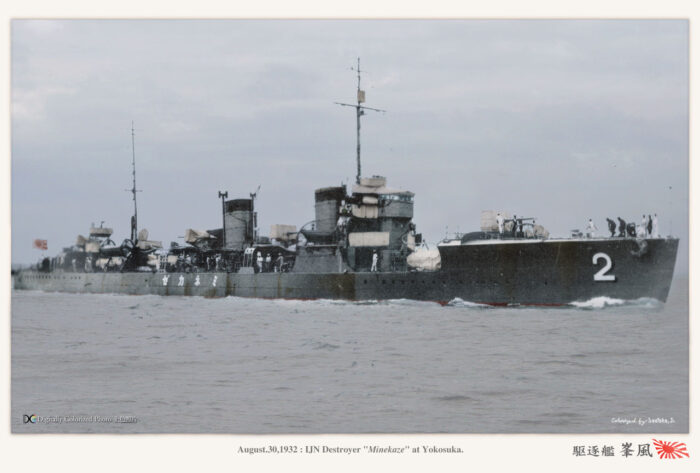
Fabulous colorization of Minekaze in 1932 by Irootoko Jr
Development
Context and Genesis
Prior to WWI, the Imperial Japanese Navy was dependent on foreign suppliers, with the British yards being favoties. Many ships were also acquired as prizes in the 1894 was with China and 1905 Russo-Japanese War, giving access to far more designs, French, Russian and German among others. The study of all these design peculiarities and comparisons allowed a unique sampling of foreign construction best methods and techniques. If earlu models came from Yarrow and Thornycroft the next ones were built under licensing agreements. With an expanding buiding capacity expanded and experience amounting, truly Japanese designs could be built, picking up elements in all past designs and create some sort of sythesis of the best western repices. The great jump was done from 1916 as the Navy issued specifications for both 1st and 2nd Class destroyers for different roles. The first were fleet destroyers, assigned to capital ships and cruisers, while the second were intended for coastal waters defence (as former torpedo boats) to protect home waters and escort convoys. These new vessels became the Minekaze and Momi classes, and only in appearance, they seemed to lean more towards German designs.
The Minekaze and momi class were quite similar in many aspects, but size. Both had a forecastle lengthened with break forward of the bridge and typical well deck in which sat their forward torpedo mount. This “toothbrush” design wa sindeed typical of German destroyers, as well as the following traditional turtledeck style forecastle, with a bow flared far more than the original, for better seakeeping qualities. They were armed with four 4.7 inches/45 cal. main guns instead of three on the Momi class, all shielded and evenly spaced along the hull, mounted high to avoid water spray interference. In short, these were a “north sea design” adapted for the Pacific.
The main armament was centerline to bear on both broadside and another difference with the Momi class were their six 21 inches or 53 cm torpedo tubes, in three twin mountings instead of just two, another advantage of their greater size. They also had Parsons geared turbines for 38,000 shaft horsepower and 39 knots (on trials). The Momi class were considerably scaled down, less powerful and fast. Both designs however suffered from the same issues, their forward gun and hull break torpedo mounting were swept in heavy seas and often unworkable. Bith they were recoignised as fast and powerful ships were equal foreign contemporaries. Only the British Shakespeare and Scott class could gave them a run for their money with triple torpedo tubes banks and five main guns, bu they were considered as leaders. The IJN approach to flotilla leaders was more cobventional as it was instead chosen to matvh these new destroyers with light cruisers, the Tenryu, Kuma, Nagara and Sendai classes. A similar approach was chosen by the USN, which did not had destroyers leaders (in 1920) or 2nd class destroyers for that matter.
Construction
Construction of these large-sized destroyers was authorized as part of the IJN 8-4 Fleet Program, fiscal 1917–1920 to accompany the 2nd class Momi, sharing many common design characteristics but the first were better armed, larger and faster as they obeyed different purposes. Thannks to their powerful engines and light construction (still riveted though) these ships reached high speeds and they were enough for a precise role, escorting the projected Amagi-class battlecruisers that were eventually cancelled due to the Washington treaty.
Two of the first batch were authorized in fiscal 1917, five in fiscal 1918 and the remainder FY 1919. None were completed by the end of the great war, so the Imperial Japanese Navy decided to continue the serie anyway to replace older destroyers and after the additional five ordered in fiscal 1919, a final three were ordered FY 1920. But they were were built to a different design and silhouette and so they are placed by most authors in their own separate sub-class.
Builders:
Maizuru Naval Arsenal: Minekaze, Okikaze, Shimakaze, Nadakaze, Tachikaze, Hokaze, Nokaze, Namikaze, Numakaze
Mitsubishi-Nagasaki shipyards: Sawakaze, Yakaze, Hakaze, Shiokaze, Akikaze, Yukaze.
Names
In typical Japanese fashion they were all named after winds. Many natural names were used for other vessels, differing by types (rivers, mountains, provinces…) and the wind evoked speed above all, which seemed fitting symbolically for their speed and role. The precise names were also in part found in traditional samurai-era poetry. “-Kaze” (風) was the common suffix. This tradition started with the very first IJN destroyers, the Azakaze class under the 1904 programme. By contrast, 2nd class destroyers such as the Momi class were named after… plants (ex. chestnut, wisteria, reed, lotus, violet).
Later in the interwar years, destroyers were allocated names associated with other natural phenomena of weather, sky and sea, like the snow (-yuki), rain (-ame), clouds (-kumo), waves (-nami), mist (-kiri), frost (-shimo), tides (-shio), and the moon (-tsuki).
Design of the class
If the Momi and Minekaze class had a lot in common, they were also two dufferently sized vessels, with the 1st class having more power and armament. Before the the innovative and typically Japanese Fubuki and Kagerō ‘Special Type’ destroyers of the 1930s, the Minekaze class can be seen as a transitional design after carefully studying five German destroyers received as war reparations after World War I: T.181, S.51, S.60, V.80 and V.127, sold and BU up in Britain or Dordrecht. They never entered IJN service but had a considerable influence.
The Minekaze were a complete break from previous British designs and methods. Seaworthiness was at the heart of concerns for the IJN, which design requirements called for a larger vessel capable of maintaining higher speeds in heavy seas unlike their predecessors.
The Minekaze class had thus many design innovations such as a lengthened forecastle with break (well deck), better protecting the bridge while procufing a low and semi protected area for the forward torpedo tubes. these were typical indeed of German designs. The main battery was also mounted as high as possible, and on the centerline with the other TT banks distributed on deck level in a more conventional fashion. In fact the “strange TT bank” was the extra one behind ther forecastle. Since WW1 german destroyers ended BU or as war prize for a short time, apart those kept for a few more years until repalcement in the Reischmarine, this made the Minekaze rather unique in WW2 and a very easy recoignition mark.
Hull and general design
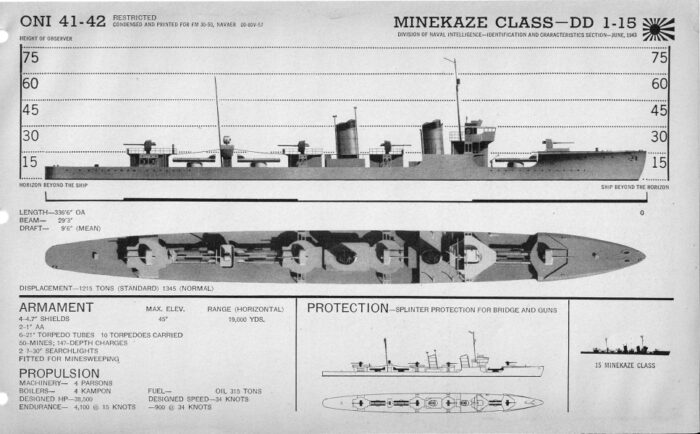
ONI depiction of the Minkaze class as built.
Apart the points underlined above, the Minekaze class were in general longer than the more compact Momi class, based on a 1,345 long tons (1,367 t) normal and 1,650 long tons (1,676 t) full load displacement versus 864 t (850 long tons) normal and 1,036 t (1,020 long tons) deep load which was a 500 tonnes difference, quite important. In size this was clear as well, the Minekaze topping at
97.5 meters or 319 ft 11 in between perpendiculars or 102.6 m (336 ft 7 in) overall versus 85.3 m (280 ft) overall on the Momis. In beam also, the Mutsuki reached 9 m (29 ft 6 in) versus 7.9 m (26 ft) so more than a meter wider, and in draft, 2.9 m (9 ft 6 in) versus 2.4 m (8 ft). This was still low enough to enable them access to rivers quite deep if needed, notably in China.
They had also a larger crew at 148 compared to the Momi class. The hull stretch enabled an extra gun on a banstand aft of the second funnel, and second TT bank aft of it. The two TT banks were separated by a small structure supporting both light projectors and a raked aft mast. The main mast comprised a spotting top. The bridge was still “prismatic” with an inverted slope to deflect water spray bouncing on the hull break base. It was “semi open”, meaning the windows which all could be lifted up, protected the forward section, with open sides and a light structure above, covered by light metal doubled with wood to reduce heat instead of a tarpaulin. Seen from above, it looked like a triangle.
Powerplant
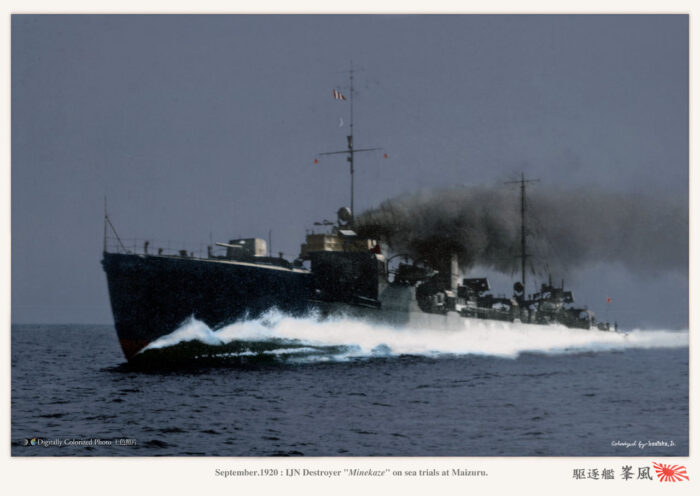
Minekaze in sea trials 1920, colorized by Irotoko Jr.
The engines were powered by four Kampon boilers, running two-shaft geared turbines for a total of 38,500 shp. To compare the Momi class had two smaller Parsons turbines and three Kampon water-tube boilers (same model) for a total of 21,500 shp (16,000 kW). The four boilers were truncated in two funnels not far apart, thus they had same size raked funnels instead of the Momi. The difference, almost twice the power was also reflected in top speed. On trials, the Mutsuki were capable of 39 knots and in reality, they exceeded that figure up to 40 knots+ in some cases.
The 39 knots (72 km/h) were also the result of geared, instead of direct-drive engines of previous designs. High fuel consumption however was still there, for limited range. In that chapter, the Minekaze were rated for 3,600 nmi (6,700 km; 4,100 mi) at 14 knots (26 km/h; 16 mph) versus 3,000 nmi (5,600 km; 3,500 mi) at 15 knots (28 km/h; 17 mph) for the Momi class, so a marginal improvement at best, not befitting their oversas deployment, high speed capital ship escort role.
Armament
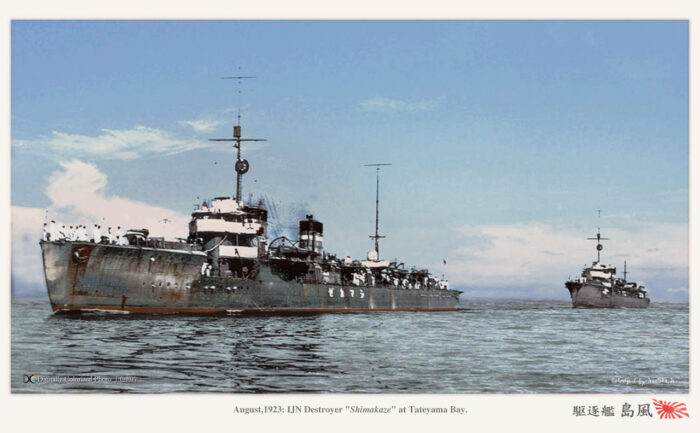
Shimakaze in Tateyama Bay in 1932, colorized by Irotoko Jr.
In brief:
-4 × 12 cm/45 (4.7 inch) type 3 naval guns in single mounts, shielded, one forward, one aft, one amidships on a bandstand.
-6x 533 mm (21 inch) torpedo tubes in three twin mounts, one forward in the hull break well, two aft.
-Two 7.7mm/80 Type 92 light AA amchine guns src
-20 mines and a mechanical minesweeping gear.
-Depth charges for anti-submarine warfare, see notes.
12 cm/45 3rd Year Type naval gun
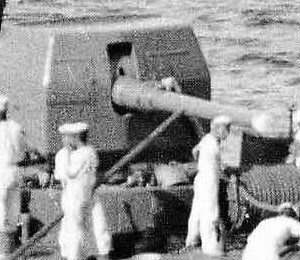 The 12 cm/45 gun was designed in 1895 as an indigenous variant of an Elswick Ordnance Pattern Y under the designation “Type 41”. In 1921 it was declined into an high-angle AA gun, the 12 cm/45 10th Year Type. The base model had a Single motion interrupted screw Welin breech block different from the Type 3 12 cm AA Gun used by the Army in 1943. On destroyers it was always shielded (photo), with the latter fitted with two opening panels.
The 12 cm/45 gun was designed in 1895 as an indigenous variant of an Elswick Ordnance Pattern Y under the designation “Type 41”. In 1921 it was declined into an high-angle AA gun, the 12 cm/45 10th Year Type. The base model had a Single motion interrupted screw Welin breech block different from the Type 3 12 cm AA Gun used by the Army in 1943. On destroyers it was always shielded (photo), with the latter fitted with two opening panels.
From 1922 the gun evolved into the 12 cm 11th Year Type naval gun (Model 1922) with a shorter gun barrel and horizontal sliding breech-block but reserved for TBs and submarines only. Manually loaded it fired a 20.3 kg (45 lb) high-explosive or illumination shell. The patrol conversions from 1943 also received an anti-submarine shell.
Thuis gun was ubiquitous for early IJN destroyers, also found on the Momi, Kawakaze, Minekaze, Mutsuki, Wakatake class destroyer as well as the Chidori/Erotofu class TBs and the Shimushu and Tsukushi class escort/survey ships of the Hashidate class gunboats.
⚙ specifications 12 cm/45 3rd Year |
|
| Weight | 3,240 kg (7,140 lb) |
| Barrel length | 5.4 m (18 ft) bore |
| Elevation/Traverse | -7° +33° and 120°/120° |
| Loading system | Welin breech block, Hydro-pneumatic recoil |
| Muzzle velocity | 825 m/s (2,710 ft/s) |
| Range | 16 km (10 mi) at 33° |
| Crew | 6 |
| Round | 20.3 kg (45 lb) 120 x 550 mm.R., sep. loading cased charge |
| Rate of Fire | 5–6 rpm |
As for torpedoes, these ships had access to a wide variety of 533 mm models, the 21″ (53.3 cm) Type 43 and Type 44 No. 1/2 1911 models, and were certainly planned with the Type 6 (1917) which entered service in 1918, with the first ships completed in late 1919 and the last in 1922.
Type 6 (1917)
Initially planned for battlecruisers and battleships of the “8-8-8” plan, later cancelled with the Washington treaty. Standard 43 cm torpedo for new cruisers and destroyers when metric was used also for these models.
⚙ specifications Type 6 |
|
| Weight | 3,157 lbs. (1,432 kg) |
| Dimensions | 269 in (6.84 m) |
| Propulsion | Kerosene-air wet-heater |
| Range/speed setting | 7,000 m/35, 10,000m/32, 15,000m/26 knots |
| Warhead | 448 lbs. (203 kg) Shimose |
| Guidance | Straight course |
Depth Charges
Standard Type 95, 30.5″ by 17.7″ (77.5cm by 45cm). 220 lb (100 kg) charge, Type 88 explosive (ammonium perchlorate and ferrosilicate). Fuse using a water inlet. 100 feet (30m) and 200 feet (60m) settings (after the revelations of a US Congressman).
Later increased to 324 lb (147kg), Type 97 explosive (70% TNA/30% HNDA), 300 foot (90m) setting.
-1944 Type 2: 230 lbs (105kg) Type 97 explosive settings 98, 197, 292, 390, 480 feet (30m, 60m, 89m, 120m, and 145m).
-1945 Type 2: 357 lbs (162kg) explosives.
Mines
20 mines on rails, no precision given. Can be any of the models here.
Sensors (WW2)
93-shiki (Type 93) sonar (1943):2 kW 4400 lbs (2000 kg) model, FRQ 17.5 kHz, receiver gain 120 decibels 2, 4, or 8 seconds pulse interval, range up to 1640-3300-6600 yards (1500m-3000m-6000m) at 3°/10° resolution.
3-shiki (Type 3) 1-go radar: Surviving destroyers in 1944-45. 2 arrays of 5 dipoles, 10 kW, wlg 20, PRF 500, range 150 km effective, 300 km max.
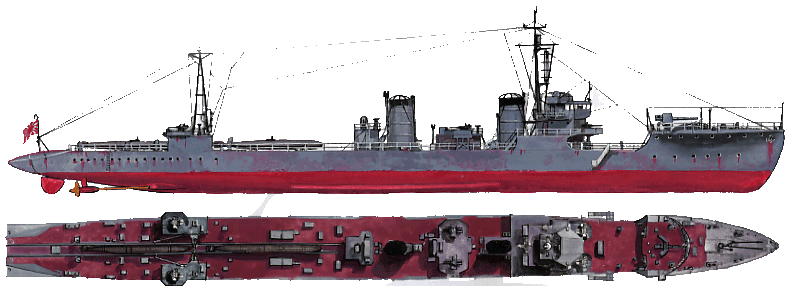
IJN Namikaze, as converted as a Kaiten transport in 1945. After being torpedoed by a US submarine and sent to Maizuru for repairs it was decided to create a new stern section, the conversion saw the removal of three of her four main guns, all torpedo launchers and first boiler, down to 25,000 ihp (19,000 kW), top speed down to 29.5 knots (54.6 km/h). Six Type 96 25 mm AT/AA Guns and eight 13.2 mm (0.52 in) AA guns added. Stern now a sloping deck, 2-4 Kaiten carried and launched on rails. Completion of the refit on 1 February 1945.
⚙ specifications |
|
| Displacement | 864 t normal, 1,036 t deep load |
| Dimensions | 85.3 x 7.9 x 2.4m (280 x 26 x 8 ft) |
| Propulsion | 2 shafts Parsons steam turbines, 3 Kampon water-tube boilers 21,500 shp (16,000 kW) |
| Speed | 36 knots (67 km/h; 41 mph) |
| Range | 3,000 nmi (5,600 km; 3,500 mi) at 15 knots (28 km/h; 17 mph) |
| Armament | 3× 12 cm (4.7 in) Type 3 guns, 2×2 53.3 cm (21 in) TTs, see notes |
| Sensors | Type 93 sonar, Type 2 mod 2 radar |
| Crew | 148 |
Modernizations and Variants in WW2
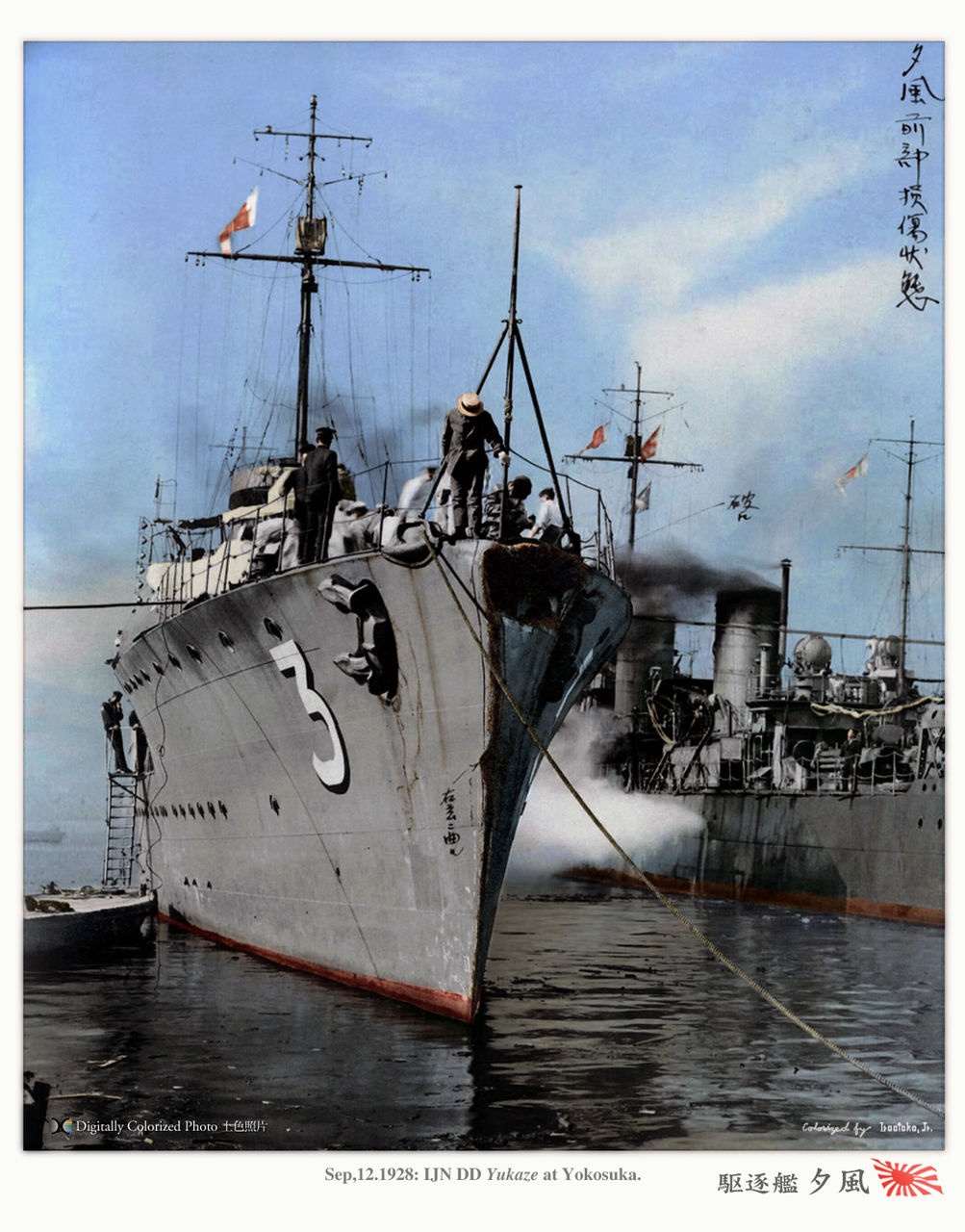
IJN Yukikaze’s prow at Yokosuka, colorized byIrootoko Jr.
In 1937, IJN Yakaze was converted into a radio control ship to control the ex-battleship Satsuma (Or Settsu). Torpedo tubes removed, main armament was reduced a single 12 cm gun. 20 July 1942, she reclassified as target ship for aircraft, all guns removed but a 50 mm (2 in) gun, four 25 mm (0.98 in) Type 96 light AA guns, power reduced to 11,260 shp (8,400 kW), speed 24 knots (44 km/h; 28 mph). She still could carry 20 mines.
In 1937–38, Nadakaze was one of the first ships which hull was strengthened, funnel caps added, fuel capacity reduced to 234 metric tons (230 long tons). In 1940, she was converted into a patrol boat, displacing 1,727 metric tons after the removal of two boilers (20 knots (37 km/h; 23 mph)) as well as two 12 cm guns, and two TT mounts. Instead she had four 25 mm (0.98 in) Type 96 light AA guns and 16 depth charges. Later she was rebuilt as a destroyer transport to carry two Daihatsu-class landing craft and 250 troops: The stern was cut down to the waterline, ramp built, she lost her last 12 cm gun aft, and remaining TTs, depth charges. The first patrol escorts were capable of 19,250 hp and 22kts, fuel stowage 300t for 1,390/1,700t displacement. Five twin 25mm/60 Type 96 and 2 DCT (16 depth charges), as well as the Type 93 sonar installed. Two ships were converted to fast attack transports and in general they only carried two 14 m Daihatsu landing craft while the removed boilers offered the accommodation for 250 SNLF marines.
In 1937–38, Hakaze had the same transformation as Nadakaze, but with her fuel capacity reduced to 300 metric tons (295 long tons). She lost two main guns, both aft TTs and four depth charge throwers (36 depth charges) plus ten 25 mm (0.98 in) Type 96 light AA guns, top speed 35 knots (65 km/h; 40 mph).
A more austere transformation was done also on Minekaze, Okikaze, Hakaze, Nadakaze, Shimakaze, Akikaze, Shiokaze, Yukaze, Hokaze, Tachikaze, Nokaze, Namikaze, Numakaze, but with 50t+ solid ballast added, displacement to 1552t, 36kts, fuel stowage 275t or 230t or 295t.
1939-1940 saw Kamikaze, Nokaze, Numakaze, Namikaze receiving this solid ballast (1652t, 34.5kts).
In 1942-43 there were further transformations. Yakaze was converted to target ship with 2 boilers removed, 11,260 hp and 24kts, one single 3-in/40 Type 3 guna nd two twin 25mm/60 Type 96.
Surviving destroyers were down to two main guns, onr TT bank, five twin 25mm/60 type 96, 4 DCT, 2 DCR (36), and a type 93 sonar.
By late 1944, from 6 to 10 single 25mm/60 type 96 were added.
From late 1944 Namikaze was converted as a Kaiter carrier, see above. She lost a single boiler and was lengthened, 28 kts. She was protected by no less than twenty 25mm/60 Type 96 guns and had a type 2 radar. Shiokaze and Yukaze had the type 3 1-go radar.
Yakaze was the last converted as patrol escort in 1945. Two main gunsb remained, five twin 25mm/60 type 96, two single ones, a twin 533mm TT, 4 DCT (36), and a type 93 sonar and later she lost one main gun, her remaining TT banks, for the addition of nine 150 ASW ro ket launcgets and a Type 2, 2-go radar.
Career of the Minekaze class
 IJN Minekaze (1919)
IJN Minekaze (1919)
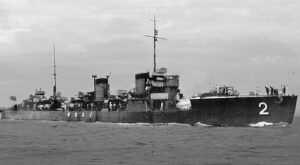 Minekaze or ‘Mountain wind’ was laid down at Maizuru Naval Arsenal on 20 Apr 1918, launched on 8 Feb 1919 and completed on 29 May 1920. With Sawakaze, Okikaze, and Yakaze at Sasebo Naval District she was in DesDiv 2, 2nd Fleet. From 1930 to 1932 DesDiv 2 assigned to the 1st Air Fleet escorting IJN Akagi, notably as plane guard during qualifications. When the First Shanghai Incident took place in 1932 Minekaze was in river patrol duties on the Yangzi. In 1937–38 she patrolled the northern and central China coastlines during the Second Sino-Japanese War.
Minekaze or ‘Mountain wind’ was laid down at Maizuru Naval Arsenal on 20 Apr 1918, launched on 8 Feb 1919 and completed on 29 May 1920. With Sawakaze, Okikaze, and Yakaze at Sasebo Naval District she was in DesDiv 2, 2nd Fleet. From 1930 to 1932 DesDiv 2 assigned to the 1st Air Fleet escorting IJN Akagi, notably as plane guard during qualifications. When the First Shanghai Incident took place in 1932 Minekaze was in river patrol duties on the Yangzi. In 1937–38 she patrolled the northern and central China coastlines during the Second Sino-Japanese War.
By December 1941, she was in the Chinkai Guard District, Korea, patroling the Tsushima Straits, Chishima Island. From April 1942 she was with the Sasebo Naval District in patrol/convoy. On 9 May, she rescueedpassengers from the Taiyō Maru sink ny a US sub. Late September saw her between Saipan, Truk and Rabaul and by late November 1942 to February 1944 in the East China Sea. On 1 February 1944, she entered the 1st Surface Escort Division (General Escort Command) a sailed from Moji with a convoy for Takao ambushed later by USS Pogy off Taiwan. Minekaze was torpedoed and sunk on 10 February 1944, 7 miles (11 km) SW off Wu-shih Pi, stricken 31 March 1944.
 IJN Sawakaze (1919)
IJN Sawakaze (1919)
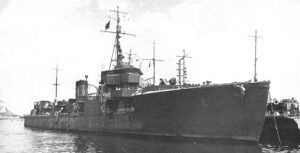 Sawakaze (“Wind from the swamp”) was laid down at Mitsubishi-Nagasaki shipyards on 7 Jan 1918, launched on 7 Jan 1919 and completed on 6 Mar 1920. Destroyer Division 2 under the Second Fleet. In 1930-1932 she was assigned to the 1st Air Fleet, escort of IJN Akagi and plane guard. With the 1st Shanghai incident of 1932, she was in river patrol duties, Yangzi River. 1935-1938 saw her at the Tateyama Naval Air Base as SAR ship. Scheduled for decom. in 1938 she stayed on active status at the Yokosuka Naval District and Tateyama until March 1942. At Yokosuka from March she performed ASW of the entrance of Tokyo Bay until 1945, wit just a single convoy escort run to Muroran, Hokkaidō or Kobe. From December 1944 she became a training ship at the Yokosuka ASW School. From May 1945 she became a target vessel for the 1st Tokko Air Corps suicide flights. In 15 August she was still in Yokosuka, decom. on 15 September 1945, stricken BU in 1947.
Sawakaze (“Wind from the swamp”) was laid down at Mitsubishi-Nagasaki shipyards on 7 Jan 1918, launched on 7 Jan 1919 and completed on 6 Mar 1920. Destroyer Division 2 under the Second Fleet. In 1930-1932 she was assigned to the 1st Air Fleet, escort of IJN Akagi and plane guard. With the 1st Shanghai incident of 1932, she was in river patrol duties, Yangzi River. 1935-1938 saw her at the Tateyama Naval Air Base as SAR ship. Scheduled for decom. in 1938 she stayed on active status at the Yokosuka Naval District and Tateyama until March 1942. At Yokosuka from March she performed ASW of the entrance of Tokyo Bay until 1945, wit just a single convoy escort run to Muroran, Hokkaidō or Kobe. From December 1944 she became a training ship at the Yokosuka ASW School. From May 1945 she became a target vessel for the 1st Tokko Air Corps suicide flights. In 15 August she was still in Yokosuka, decom. on 15 September 1945, stricken BU in 1947.
 IJN Okikaze (1919)
IJN Okikaze (1919)
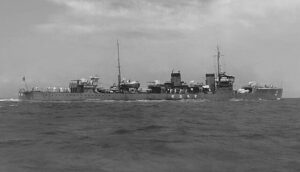 Okikaze (“Offshore wind”) was laid down at Maizuru on 22 Feb 1919, launched on 3 Oct 1919 and completed on 17 Aug 1920. Destroyer Division 2 under the IJN 2nd Fleet. 1930 to 1932, 1st Air Fleet, Akagi. 1st Shanghai incident 1932, river patrol duties, Yangzi River. December 1941, Ōminato Guard District (northern Japan) patroled the Tsugaru Strait, coastline, southern Hokkaidō. April 1942, Yokosuka Naval District, ASW patrols in Tokyo Bay, with convoy escort run to Kushimoto, Wakayama. Patrolled northern Honshū until Dec. 1942.
Okikaze (“Offshore wind”) was laid down at Maizuru on 22 Feb 1919, launched on 3 Oct 1919 and completed on 17 Aug 1920. Destroyer Division 2 under the IJN 2nd Fleet. 1930 to 1932, 1st Air Fleet, Akagi. 1st Shanghai incident 1932, river patrol duties, Yangzi River. December 1941, Ōminato Guard District (northern Japan) patroled the Tsugaru Strait, coastline, southern Hokkaidō. April 1942, Yokosuka Naval District, ASW patrols in Tokyo Bay, with convoy escort run to Kushimoto, Wakayama. Patrolled northern Honshū until Dec. 1942.
On 10 January 1943 she was torpedoed by USS Trigger 35 miles (56 km) southeast of Yokosuka, nearby Katsura Lighthouse. Her well deck was hit and the hull broek at the forecastle up at a 45° angle and her stern was also hir, she sank with almost no survivors, stricken 1 March 1944.
 IJN Shimakaze (1920)
IJN Shimakaze (1920)
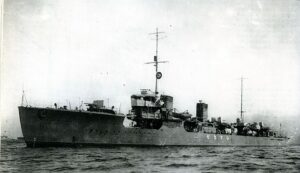 IJN Shimakaze (‘Wind on the island’) was laid down at Maizuru on 5 Sep 1919, launched on 31 Mar 1920 and completed on 15 Nov 1920. She was assigned to the Yokosuka Naval District DesDiv 3, 2nd Fleet. On 11 October 1928 in Uraga Channel she collided with Yūkaze while in manoeuvers by night, having her port side mushed and extensive repairs. Took part in the Battle of Shanghai on 25 September 1937, cover fire in the Huangpu River in the Second Sino-Japanese War, under fire from Chinese troops, wounding DesDiv 3 commanding officer, Lt Cdr Prince Fushimi Hiroyoshi. 1938-1939, assigned to patrols, northern and central China coastlines. December 1938, DesDiv 3 disbanded, sent to reserve. April 1940, after modifications, recomm. as No.1-class patrol boat (Dai-ichi-gō Shōkaitei) in the Philippines, Netherlands East Indies Solomon Islands. Lost on 12 January 1943 while escorting the fleet oiler Akebono, Bismarck Archipelago, by USS Guardfish near Kavieng, New Ireland. Stricken 10 February 1943.
IJN Shimakaze (‘Wind on the island’) was laid down at Maizuru on 5 Sep 1919, launched on 31 Mar 1920 and completed on 15 Nov 1920. She was assigned to the Yokosuka Naval District DesDiv 3, 2nd Fleet. On 11 October 1928 in Uraga Channel she collided with Yūkaze while in manoeuvers by night, having her port side mushed and extensive repairs. Took part in the Battle of Shanghai on 25 September 1937, cover fire in the Huangpu River in the Second Sino-Japanese War, under fire from Chinese troops, wounding DesDiv 3 commanding officer, Lt Cdr Prince Fushimi Hiroyoshi. 1938-1939, assigned to patrols, northern and central China coastlines. December 1938, DesDiv 3 disbanded, sent to reserve. April 1940, after modifications, recomm. as No.1-class patrol boat (Dai-ichi-gō Shōkaitei) in the Philippines, Netherlands East Indies Solomon Islands. Lost on 12 January 1943 while escorting the fleet oiler Akebono, Bismarck Archipelago, by USS Guardfish near Kavieng, New Ireland. Stricken 10 February 1943.
 IJN Nadakaze (1920)
IJN Nadakaze (1920)
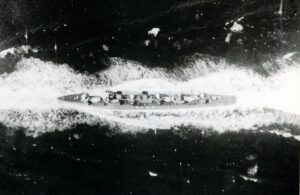 Nadakaze (‘Wind on the open sea’) was laid down at Maizuru on 9 Jan 1920, launched on 26 Jun 1920 and completed on 30 Sep 1921. Nadakaze, built at the Maizuru Naval Arsenal, was laid down on 9 January 1920, launched on 26 June 1920 and completed on 30 September 1921, assigned to Yokosuka Naval District, DesDiv 3, 2nd Fleet. From 1937 to 1939 she patrolled the northern and central China coastlines, Sino-Japanese War. December 1938 saw her unit disbanded, she was reassigned to the reserves. In April 1940, after modifications she became No.2-class patrol boat. Philippines, Netherlands East Indies, Solomon Islands. January 1943, reassigned to the home islands, escorting convoys between Moji, Takao, Saigon, Manila and Singapore. December 1943, support ship for IJN Land Forces Balikpapan, Borneo. 25 July 1945, torpedoed and sunk by HMS Stubborn near Lombok Strait, Sunda Islands, stricken 30 September 1945.
Nadakaze (‘Wind on the open sea’) was laid down at Maizuru on 9 Jan 1920, launched on 26 Jun 1920 and completed on 30 Sep 1921. Nadakaze, built at the Maizuru Naval Arsenal, was laid down on 9 January 1920, launched on 26 June 1920 and completed on 30 September 1921, assigned to Yokosuka Naval District, DesDiv 3, 2nd Fleet. From 1937 to 1939 she patrolled the northern and central China coastlines, Sino-Japanese War. December 1938 saw her unit disbanded, she was reassigned to the reserves. In April 1940, after modifications she became No.2-class patrol boat. Philippines, Netherlands East Indies, Solomon Islands. January 1943, reassigned to the home islands, escorting convoys between Moji, Takao, Saigon, Manila and Singapore. December 1943, support ship for IJN Land Forces Balikpapan, Borneo. 25 July 1945, torpedoed and sunk by HMS Stubborn near Lombok Strait, Sunda Islands, stricken 30 September 1945.
 IJN Yakaze (1920)
IJN Yakaze (1920)
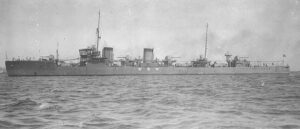 Yakaze (‘Wind of an arrow’s flight’) was laid down at Mitsubishi on 15 August 1918, launched on 10 April 1920 and completed on 19 July 1920. She was assigned to the Kure Naval District, 2nd Fleet. In 1931 with Minekaze, Okikaze, and Sawakaze she formed DesDiv 2 at Sasebo Naval District, 1st Air Fleet escorting Akagi and Hōshō and plane guard. In 1932 she was in river patrol duties along the Yangzi. 11 March 1939 saw her colliding with I-61. She had heavy damage and flooding in the Attack on Yokosuka on 18 July 1945, towed to Nagaura in No. 2 drydock, but sank due to lack of repairs. Scrapped 1947.
Yakaze (‘Wind of an arrow’s flight’) was laid down at Mitsubishi on 15 August 1918, launched on 10 April 1920 and completed on 19 July 1920. She was assigned to the Kure Naval District, 2nd Fleet. In 1931 with Minekaze, Okikaze, and Sawakaze she formed DesDiv 2 at Sasebo Naval District, 1st Air Fleet escorting Akagi and Hōshō and plane guard. In 1932 she was in river patrol duties along the Yangzi. 11 March 1939 saw her colliding with I-61. She had heavy damage and flooding in the Attack on Yokosuka on 18 July 1945, towed to Nagaura in No. 2 drydock, but sank due to lack of repairs. Scrapped 1947.
 IJN Hakaze (1920)
IJN Hakaze (1920)
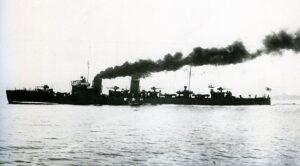 Hakaze (‘Wind of a bird’s flight’) was laid down at Mitsubishi on 11 Nov 1918, launched on 21 Jun 1920 and completed on 16 Sep 1920. From 1937 to 1938 she patrolled the northern and central China coastlines and from December 1941, she joined DesDiv 14, 11th Air Fleet, based at Cape St. Jacques, south of Saigon (French Indochina) in support of the 22nd Air Flotilla. She carried materials to Miri and Kuching in Sarawak and Kota Bharu in Malaya for the construction of forward air bases. In February 1942 she took part in Operation L, the invasion of Palembang, Sumatra and was based in Bangka, for ASW patrols. She was back in Bangkok in March, Singapore in April. In May she was in Rabaul, Solomons for Operation Mo, the invasion of Port Moresby. She had a refit at Maizuru and escorted a convoy to Saipan, and Hahajima, Ogasawara Islands. In August another from Saipan to Rabaul, and patrols there until October. She escorted several convoys before the Guadalcanal offensive and in November was part of the “Tokyo Express” from Buin to Munda, four transport runs. Until 20 January 1943, she kept patrolling the Shortlands–Buka–Rabaul–Kavieng sector and escorted the seaplane tender Akitsushima, attacking USS Guardfish (escaped) but torpedoed, sunk on 23 January 1943 (by the same) south of Kavieng in New Ireland and stricken on 1 March 1943.
Hakaze (‘Wind of a bird’s flight’) was laid down at Mitsubishi on 11 Nov 1918, launched on 21 Jun 1920 and completed on 16 Sep 1920. From 1937 to 1938 she patrolled the northern and central China coastlines and from December 1941, she joined DesDiv 14, 11th Air Fleet, based at Cape St. Jacques, south of Saigon (French Indochina) in support of the 22nd Air Flotilla. She carried materials to Miri and Kuching in Sarawak and Kota Bharu in Malaya for the construction of forward air bases. In February 1942 she took part in Operation L, the invasion of Palembang, Sumatra and was based in Bangka, for ASW patrols. She was back in Bangkok in March, Singapore in April. In May she was in Rabaul, Solomons for Operation Mo, the invasion of Port Moresby. She had a refit at Maizuru and escorted a convoy to Saipan, and Hahajima, Ogasawara Islands. In August another from Saipan to Rabaul, and patrols there until October. She escorted several convoys before the Guadalcanal offensive and in November was part of the “Tokyo Express” from Buin to Munda, four transport runs. Until 20 January 1943, she kept patrolling the Shortlands–Buka–Rabaul–Kavieng sector and escorted the seaplane tender Akitsushima, attacking USS Guardfish (escaped) but torpedoed, sunk on 23 January 1943 (by the same) south of Kavieng in New Ireland and stricken on 1 March 1943.
 IJN Shiokaze (1920)
IJN Shiokaze (1920)
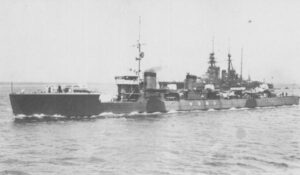 Shiokaze (‘Wind springing up at the turn of a tide’) was laid down at Maizuru on 15 May 1920, launched on 22 October and completed on 29 Jul 1921. She was assigned to the Yokosuka Naval District and from 9 March 1928, in torpedo launch trials off Yokosuka when colliding with the submarine I-21 in speed trials, with light damage. In 1938 and 1939, she patrolled the southern coastline of China and in 1942, was in convoy escort duties with DesDiv 3, 1st Air Fleet (Kido Butai) based at Palau, attached to IJN Ryūjō for Operation M, the invasion of the Philippines.
Shiokaze (‘Wind springing up at the turn of a tide’) was laid down at Maizuru on 15 May 1920, launched on 22 October and completed on 29 Jul 1921. She was assigned to the Yokosuka Naval District and from 9 March 1928, in torpedo launch trials off Yokosuka when colliding with the submarine I-21 in speed trials, with light damage. In 1938 and 1939, she patrolled the southern coastline of China and in 1942, was in convoy escort duties with DesDiv 3, 1st Air Fleet (Kido Butai) based at Palau, attached to IJN Ryūjō for Operation M, the invasion of the Philippines.
From early January 1942 she was based at Cam Ranh Bay, French Indochina for the invasion of Sarawak, Borneo, Palembang Operation L and Java, Operation J. On 2 March 1942 she assisted Matsukaze in sinking the Dutch minesweeper Endeh. In March she escorted Ryūjō for the Invasion of the Andaman Islands and Indian Ocean raids. On 10 April 1942, she joined the 5th Fleet for Operation AL in the Aleutian Islands. Next, she escorted convoys between Japan and Taiwan.
She had a refit modernization by early 1943 and escorted convoys between Japan and Manila, Singapore and Palau until January 1945. She was attacked by air raid at Taiwan on 31 January 1945 when evacuating aircraft crews from Aparri on Luzon but repaired at Kure Naval Arsenal were never completed, until the surrender of Japan. She became a war reparation vessel, evacuating demobilized Japanese troops and on 5 October 1945 stricken, scuttled for the breakwater at Onahama Port (Fukushima).
 IJN Akikaze (1920)
IJN Akikaze (1920)
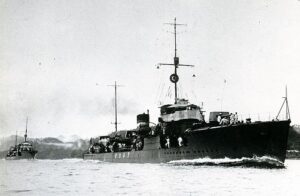 Akikaze (‘Autumn wind’) was laid down at Mitsubishi on 7 Jun 1920, launched on 14 Dec 1920 and completed on 16 Sep 1921. Akikaze joined Hakaze, Tachikaze, and Hokaze at the Yokosuka Naval District, DesDiv 4, Torpedo Squadron 1. In 1938–1939, she patrolled the central China coastline and in 1942, in patrol and convoy escort duties with DesDiv 34, 11th Air Fleet based at Takao, used for air sea rescue support for Operation M and convoys to Davao and Legazpi. Until April 1942 she operated from Davao, and and from Ambon. Refit at Maizuru May 1942, then based at Rabaul. 14 March 1943 attacked what possibly was USS Triton near Kairiru Island. Refit, Rabaul, heavily damaged, air raid 2 August. A bomb hit killed Captain Tsurukichi Sabe, 22 casualties. Repaired in Maizuru September, back mid-November. Made several “Tokyo Express” runs to New Guinea until February 1944. March, reassigned to Truk for convoys to Saipan and Palau. 1 May 1944, DesDic 30, Central Pacific Fleet convoys from Japan to Davao and Manila, based there, joined the Combined Fleet on 20 August and on 24–25 October, led escort, 2nd Supply Force (Admiral Ozawa) Northern Force in the Battle of Leyte Gulf. Rescue crew from fleet oiler Jinei Maru. 1 November under Yūzuki flagship and with Uzuki, she left Mako, escorting Jun’yō, cruiser Kiso to Brunei. 3 November attacked by USS Pintado. Akikaze under Captain Nitaro Yamazaki, intercepted the spread towards Junyo and sacrificd his ship, sinking with all 205 hands at 257 km (160 mi) west of Cape Bolinao (Luzon), 10 January 1945.
Akikaze (‘Autumn wind’) was laid down at Mitsubishi on 7 Jun 1920, launched on 14 Dec 1920 and completed on 16 Sep 1921. Akikaze joined Hakaze, Tachikaze, and Hokaze at the Yokosuka Naval District, DesDiv 4, Torpedo Squadron 1. In 1938–1939, she patrolled the central China coastline and in 1942, in patrol and convoy escort duties with DesDiv 34, 11th Air Fleet based at Takao, used for air sea rescue support for Operation M and convoys to Davao and Legazpi. Until April 1942 she operated from Davao, and and from Ambon. Refit at Maizuru May 1942, then based at Rabaul. 14 March 1943 attacked what possibly was USS Triton near Kairiru Island. Refit, Rabaul, heavily damaged, air raid 2 August. A bomb hit killed Captain Tsurukichi Sabe, 22 casualties. Repaired in Maizuru September, back mid-November. Made several “Tokyo Express” runs to New Guinea until February 1944. March, reassigned to Truk for convoys to Saipan and Palau. 1 May 1944, DesDic 30, Central Pacific Fleet convoys from Japan to Davao and Manila, based there, joined the Combined Fleet on 20 August and on 24–25 October, led escort, 2nd Supply Force (Admiral Ozawa) Northern Force in the Battle of Leyte Gulf. Rescue crew from fleet oiler Jinei Maru. 1 November under Yūzuki flagship and with Uzuki, she left Mako, escorting Jun’yō, cruiser Kiso to Brunei. 3 November attacked by USS Pintado. Akikaze under Captain Nitaro Yamazaki, intercepted the spread towards Junyo and sacrificd his ship, sinking with all 205 hands at 257 km (160 mi) west of Cape Bolinao (Luzon), 10 January 1945.
 IJN Yūkaze (1921)
IJN Yūkaze (1921)
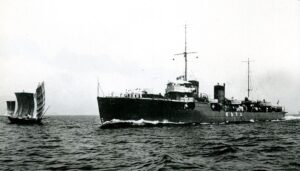 Yūkaze (‘Evening breeze’) was laid down at Mitsubishi on 14 Dec 1920, launched on 28 Apr 1921 and completed on 24 Aug 1921. Yokosuka Naval District DesDiv 3, 2nd Fleet. 11 October 1928 Uraga Channel, night training maneuvers she collided with Shimakaze, significant damage. 1937-1938 patrolled of the central China coastlines. Dec. 1941 CarDiv 3, 1st Fleet, Kure Naval District, IJN Hōshō. She took part in the Battle of Midway. She remained later in the Inland Sea. On 5 October 1945 she was stricken. Repatriation vessel from October 1945 to August 1947, war prize RN, in Singapore, BU.
Yūkaze (‘Evening breeze’) was laid down at Mitsubishi on 14 Dec 1920, launched on 28 Apr 1921 and completed on 24 Aug 1921. Yokosuka Naval District DesDiv 3, 2nd Fleet. 11 October 1928 Uraga Channel, night training maneuvers she collided with Shimakaze, significant damage. 1937-1938 patrolled of the central China coastlines. Dec. 1941 CarDiv 3, 1st Fleet, Kure Naval District, IJN Hōshō. She took part in the Battle of Midway. She remained later in the Inland Sea. On 5 October 1945 she was stricken. Repatriation vessel from October 1945 to August 1947, war prize RN, in Singapore, BU.
 IJN Tachikaze (1921)
IJN Tachikaze (1921)
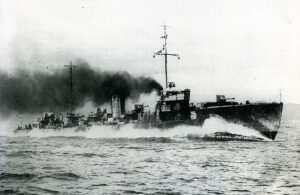 Tachikaze (‘Wind caused by the stroke of a sword’) was laid down at Maizuru on 18 Aug 1920, launched on 31 Mar 1921 and completed on 5 Dec 1921. She teamed with Hakaze, Akikaze, and Hokaze at the Yokosuka Naval District, DesDiv 4, Torpedo Squadron 1. 1938-1939 patrolled central China coastline, detached in support of the Japanese Invasion of French Indochina, 1940. Assigned to DesDiv 34, 11th Air Fleet 1942, based at Takao, SAR for invasion of the Philippines, escort convoys to Davao and Balikpapan. From 27 February to late March 1942, based at Staring-baai, escorts between Sulawesi and Singapore. Took part in the Invasion of the Andaman Islands in April. Refit in Maizuru. June to late 1942, based at Jaluit Atoll and Rabaul escorts to the Marshall and Solomon. Badly damaged air raid Rabaul on 27 December, Captain Yasumi Hirasata killed. Early 1943, emergency repairs by Yamabiko Maru, sent to Maizuru, completed 10 March 1943. Back to Rabaul, damaged by air raid on Wewak, 15 April. Maizuru for repairs in May, until September. She was based at Truk, for local patrols from Palau towards Rabaul. 4 February 1944 she ran aground at Kuop Atoll near Truk, remained stranded. During Operation Hailstone on 17–18 February she was sfrated and took a torpedo hit in the engine room, sank by the stern. Stricken 31 March 1944.
Tachikaze (‘Wind caused by the stroke of a sword’) was laid down at Maizuru on 18 Aug 1920, launched on 31 Mar 1921 and completed on 5 Dec 1921. She teamed with Hakaze, Akikaze, and Hokaze at the Yokosuka Naval District, DesDiv 4, Torpedo Squadron 1. 1938-1939 patrolled central China coastline, detached in support of the Japanese Invasion of French Indochina, 1940. Assigned to DesDiv 34, 11th Air Fleet 1942, based at Takao, SAR for invasion of the Philippines, escort convoys to Davao and Balikpapan. From 27 February to late March 1942, based at Staring-baai, escorts between Sulawesi and Singapore. Took part in the Invasion of the Andaman Islands in April. Refit in Maizuru. June to late 1942, based at Jaluit Atoll and Rabaul escorts to the Marshall and Solomon. Badly damaged air raid Rabaul on 27 December, Captain Yasumi Hirasata killed. Early 1943, emergency repairs by Yamabiko Maru, sent to Maizuru, completed 10 March 1943. Back to Rabaul, damaged by air raid on Wewak, 15 April. Maizuru for repairs in May, until September. She was based at Truk, for local patrols from Palau towards Rabaul. 4 February 1944 she ran aground at Kuop Atoll near Truk, remained stranded. During Operation Hailstone on 17–18 February she was sfrated and took a torpedo hit in the engine room, sank by the stern. Stricken 31 March 1944.
 IJN Hokaze (1921)
IJN Hokaze (1921)
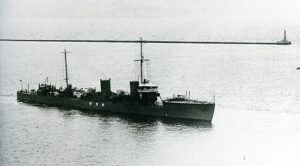 Hokaze (‘Wind on the sail’) was laid down at Maizuru on 30 Nov 1920, launched on 12 Jul 1921 and completed on 22 Dec 1921. With Hakaze, Akikaze, and Tachikaze, Yokosuka Naval District, DesDiv 4, Torpedo Squadron 1. China patrols 1938–1939, DesDiv 3 in Dec. 1941, assigned CarDiv 4. Until mid-December, escorted Taiyō from Sasebo to Takao, Palau and back and Kure. Then escorted Shōhō to Truk. April, she reported to 5th Fleet as escort for the cruiser Nachi. From late May, northern operations (Ōminato Guard District) and Kiska Invasion transports. August 1944, escortred the tender Kimikawa Maru to Kiska. October, she was assigned to the Southwest Area Fleet, convoys between Moji and Taiwan. March 1943, modernized, April based in Balikpapan, Borneo. July 1943 escorted 3 ships torpedoed byUSS Thresher in Makassar Strait, moderate damage herself. Emergency repairs, escorted a convoy from Surabaya back to Yokosuka, drydocked and repaired until mid-November 1943. Assigned to the 1st Surface Escort Division, General Escort Command. March 1944, escort from Yokosuka to Qingdao, reported to 9th Fleet. April 1944, sent to western New Guinea, 4th Southern Expeditionary Fleet, Southwest Area Fleet. 2 July 1944, left Ambon, first “Tokyo Express” run to New Guinea. 6 July 1944, torpedoed and sunk by USS Paddle in the Celebes Sea north-northeast of Menado. Her captain Eiichi Someya went down wit her. Stricken 10 September 1944.
Hokaze (‘Wind on the sail’) was laid down at Maizuru on 30 Nov 1920, launched on 12 Jul 1921 and completed on 22 Dec 1921. With Hakaze, Akikaze, and Tachikaze, Yokosuka Naval District, DesDiv 4, Torpedo Squadron 1. China patrols 1938–1939, DesDiv 3 in Dec. 1941, assigned CarDiv 4. Until mid-December, escorted Taiyō from Sasebo to Takao, Palau and back and Kure. Then escorted Shōhō to Truk. April, she reported to 5th Fleet as escort for the cruiser Nachi. From late May, northern operations (Ōminato Guard District) and Kiska Invasion transports. August 1944, escortred the tender Kimikawa Maru to Kiska. October, she was assigned to the Southwest Area Fleet, convoys between Moji and Taiwan. March 1943, modernized, April based in Balikpapan, Borneo. July 1943 escorted 3 ships torpedoed byUSS Thresher in Makassar Strait, moderate damage herself. Emergency repairs, escorted a convoy from Surabaya back to Yokosuka, drydocked and repaired until mid-November 1943. Assigned to the 1st Surface Escort Division, General Escort Command. March 1944, escort from Yokosuka to Qingdao, reported to 9th Fleet. April 1944, sent to western New Guinea, 4th Southern Expeditionary Fleet, Southwest Area Fleet. 2 July 1944, left Ambon, first “Tokyo Express” run to New Guinea. 6 July 1944, torpedoed and sunk by USS Paddle in the Celebes Sea north-northeast of Menado. Her captain Eiichi Someya went down wit her. Stricken 10 September 1944.
 IJN Nokaze (1921)
IJN Nokaze (1921)
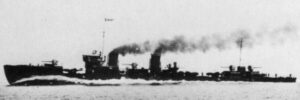 Nokaze (‘Wind over the field’), laid down at Maizuru on 16 Apr 1921, launched on 1 Oct 1921 and completed on 31 Mar 1922. Assigned DesDiv 1. 1938–1939, patrolled northern/central China coastlines. Dec. 1941, she was in Ōminato Guard District, northern Japan, patrolled Hokkaidō and Chishima Islands. Reserve force in the Battle of Midway, May 1942, deployed to the Aleutian Islands. Back to Ōminato through July 1943, joined 5th Fleet to evacuate surviving Japanese forces in Operation Cottage, evacuation of Kiska. Kept in northern waters until January 1945, reassigned to the Combined Fleet, sailed with Convoy HI-91 for Singapore. Ordered to Mako, joined the screen of IJN Ise and Hyūga for Operation Kita. 15 February, re-routed to Singapore. 20 February she was torpedoed and sunk by USS Pargo north of Nha Trang (French Indochina), 209 killed, 21 survivors inc. captain Tarō Ebihara. Last of 39 Japanese destroyers sunk by US subs in WW2. Stricken 10 April 1945.
Nokaze (‘Wind over the field’), laid down at Maizuru on 16 Apr 1921, launched on 1 Oct 1921 and completed on 31 Mar 1922. Assigned DesDiv 1. 1938–1939, patrolled northern/central China coastlines. Dec. 1941, she was in Ōminato Guard District, northern Japan, patrolled Hokkaidō and Chishima Islands. Reserve force in the Battle of Midway, May 1942, deployed to the Aleutian Islands. Back to Ōminato through July 1943, joined 5th Fleet to evacuate surviving Japanese forces in Operation Cottage, evacuation of Kiska. Kept in northern waters until January 1945, reassigned to the Combined Fleet, sailed with Convoy HI-91 for Singapore. Ordered to Mako, joined the screen of IJN Ise and Hyūga for Operation Kita. 15 February, re-routed to Singapore. 20 February she was torpedoed and sunk by USS Pargo north of Nha Trang (French Indochina), 209 killed, 21 survivors inc. captain Tarō Ebihara. Last of 39 Japanese destroyers sunk by US subs in WW2. Stricken 10 April 1945.
 IJN Namikaze (1922)
IJN Namikaze (1922)
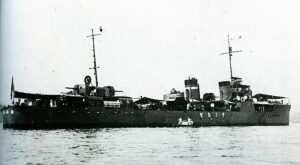 Namikaze (“Wind on the waves”) was laid down Maizuru on 7 Nov 1921, launched on 24 Jun 1922 and commissioned on 11 Nov 1922. Yokosuka Naval District DesDiv 1, patrolled northern and central China coastlines 1937-39. Dec. 1941 Ōminato Guard District, patrolled Hokkaidō-Chishima. Reserved force for the Aleutians during the Battle of Midway. Joined 5th Fleet for Kiska evacuation as backup. Collision with the coastal patrol vessel Manei Maru No.7 at Otaru port in Hokkaidō, 6 November 1943. Remained at Ōminato until December 1943. Reassigned to Moji for convoys to French Indochina. 21 August 1944 she was torpedoed by USS Seal north of Iturup. Stern broke but bulkheads held. Towed by IJN Kamikaze to Otaru for emergency repairs and final at Maizuru. Rebuilt to carry Kaiten manned torpedoes.
Namikaze (“Wind on the waves”) was laid down Maizuru on 7 Nov 1921, launched on 24 Jun 1922 and commissioned on 11 Nov 1922. Yokosuka Naval District DesDiv 1, patrolled northern and central China coastlines 1937-39. Dec. 1941 Ōminato Guard District, patrolled Hokkaidō-Chishima. Reserved force for the Aleutians during the Battle of Midway. Joined 5th Fleet for Kiska evacuation as backup. Collision with the coastal patrol vessel Manei Maru No.7 at Otaru port in Hokkaidō, 6 November 1943. Remained at Ōminato until December 1943. Reassigned to Moji for convoys to French Indochina. 21 August 1944 she was torpedoed by USS Seal north of Iturup. Stern broke but bulkheads held. Towed by IJN Kamikaze to Otaru for emergency repairs and final at Maizuru. Rebuilt to carry Kaiten manned torpedoes.
Assigned to the Combined Fleet, no record of launching Kaiten. 16 June 1945, based at Ube, Inland Sea, used as minesweeper (mines dropped by B-29 Superfortress bombers). At Kure at the surrender of Japan. 5 October 1945, stricken, demilitarized, used by occupation authorities as repatriation ship until 1947. Transferred as war prize to the Republic of China on 3 October 1947, renamed Shen Yangn based in Qingdao from 1947, evacuated to Taiwan, served until 1960, BU.
 IJN Numikaze (1922)
IJN Numikaze (1922)
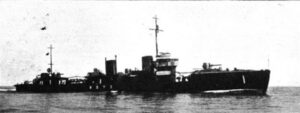 Numakaze (‘Wind over the marsh’) was laid down at Maizuru on 10 August 1921, launched on 22 May 1922 and completed on 24 July 1922. With Namikaze, Nokaze and flagship Kamikaze she was in DesDiv 1. In 1938-1939, she patrolled the northern and central China coastlines. In early 1942 she was in the Ōminato Guard District, Hokkaidō and Chishima. During the Battle of Midway, reserve force, Aleutian Islands Operation. She patrolled around Ōminato until July 1943, reassigned to the 5th Fleet for the Kiska evacuation. 6 June 1943 saw her in a collision with Shirakumo. Stayed at Ōminato until December 1943, reassigned to the Combined Fleet, 1st Surface Escort Division to Taiwan. 18 December 1943, while chasing the wake of USS Grayback, she was hit by a torpedo, blew up and sank NE of Naha (Okinawa) with all hands, including commanding officer of DesDiv 1, Commander Watanabe Yasumasa. Stricken 5 February 1944.
Numakaze (‘Wind over the marsh’) was laid down at Maizuru on 10 August 1921, launched on 22 May 1922 and completed on 24 July 1922. With Namikaze, Nokaze and flagship Kamikaze she was in DesDiv 1. In 1938-1939, she patrolled the northern and central China coastlines. In early 1942 she was in the Ōminato Guard District, Hokkaidō and Chishima. During the Battle of Midway, reserve force, Aleutian Islands Operation. She patrolled around Ōminato until July 1943, reassigned to the 5th Fleet for the Kiska evacuation. 6 June 1943 saw her in a collision with Shirakumo. Stayed at Ōminato until December 1943, reassigned to the Combined Fleet, 1st Surface Escort Division to Taiwan. 18 December 1943, while chasing the wake of USS Grayback, she was hit by a torpedo, blew up and sank NE of Naha (Okinawa) with all hands, including commanding officer of DesDiv 1, Commander Watanabe Yasumasa. Stricken 5 February 1944.
Read More/Src
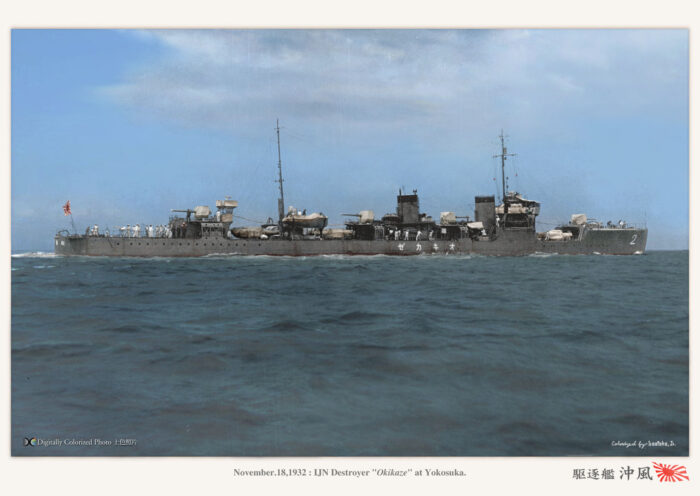
IJN Yukikaze in Yokosuka 1932, colorized by Irootoko Jr.
Books
Jentsura, Warships of the Imperial Japanese Navy, 1869-1945
Howarth, The Fighting Ships of the Rising Sun
Globalsecurity.org, IJN Momi class destroyers
Stille, Mark (2017). Imperial Japanese Navy Antisubmarine Escorts 1941–45. Oxford, UK: Osprey Publishing.
Destroyers of World War Two: An International Encyclopedia. pp. 188/189
Gardiner, Robert & Gray, Randal, eds. (1985). Conway’s All the World’s Fighting Ships 1906–1921.
Evans, David (1979). Kaigun: Strategy, Tactics, and Technology in the Imperial Japanese Navy, 1887-1941. USNI
Howarth, Stephen (1983). The Fighting Ships of the Rising Sun: The Drama of the Imperial Japanese Navy, 1895–1945. Atheneum
Jentschura, Hansgeorg; Jung, Dieter & Mickel, Peter (1977). Warships of the Imperial Japanese Navy, 1869–1945. NIP
Watts, Anthony J. & Gordon, Brian G. (1971). The Imperial Japanese Navy. Garden City, New York: Doubleday.
Links
on smmlonline.com/
combinedfleet.com Momi class
globalsecurity.org minekaze-dd.htm
on pwencycl.kgbudge.com/ pacific encyclo
on admiral31.world.coocan.jp
on maritimequest.com/
on en.wikipedia.org
ordnanceandmilitaria.com 110-to-149mm-ammo
navypedia.org/ minekaze.htm
navweaps.com/ 120mm/45
navweaps.com 120mm/45
List_of_Japanese_World_War_II_radars
navweaps.com/ Pre WWII torpedoes
pwencyc IJN Depth_Charges
momi class on commons.wikimedia.org
smmlonline.com/ minekaze.html
combinedfleet.com minekaze
combinedfleet.com sawakaze
More TROM combinedfleet.com/lancers.htm
amazing Minekaze class colorizations by irootoko Jr on blog.livedoor.jp


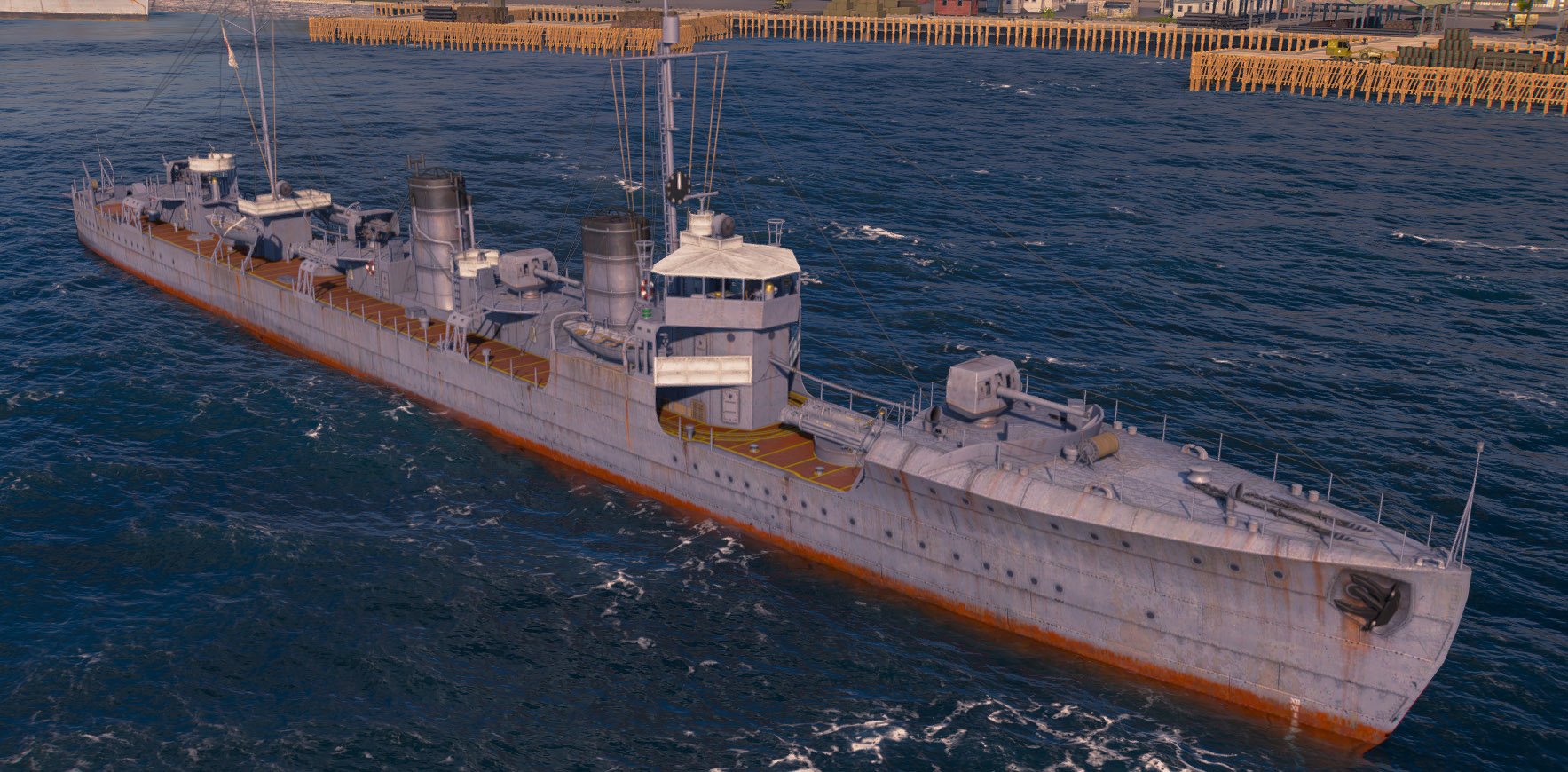
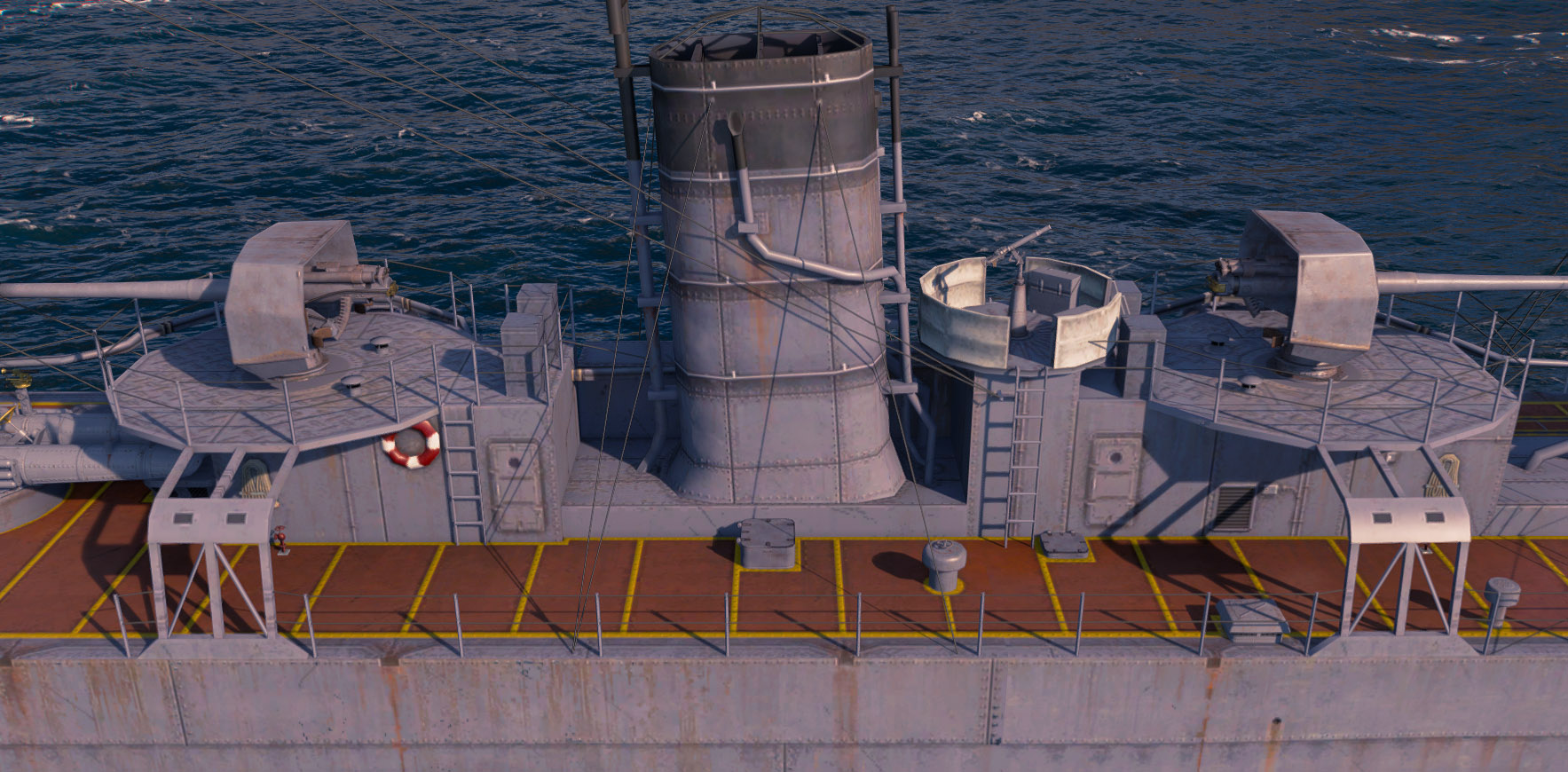
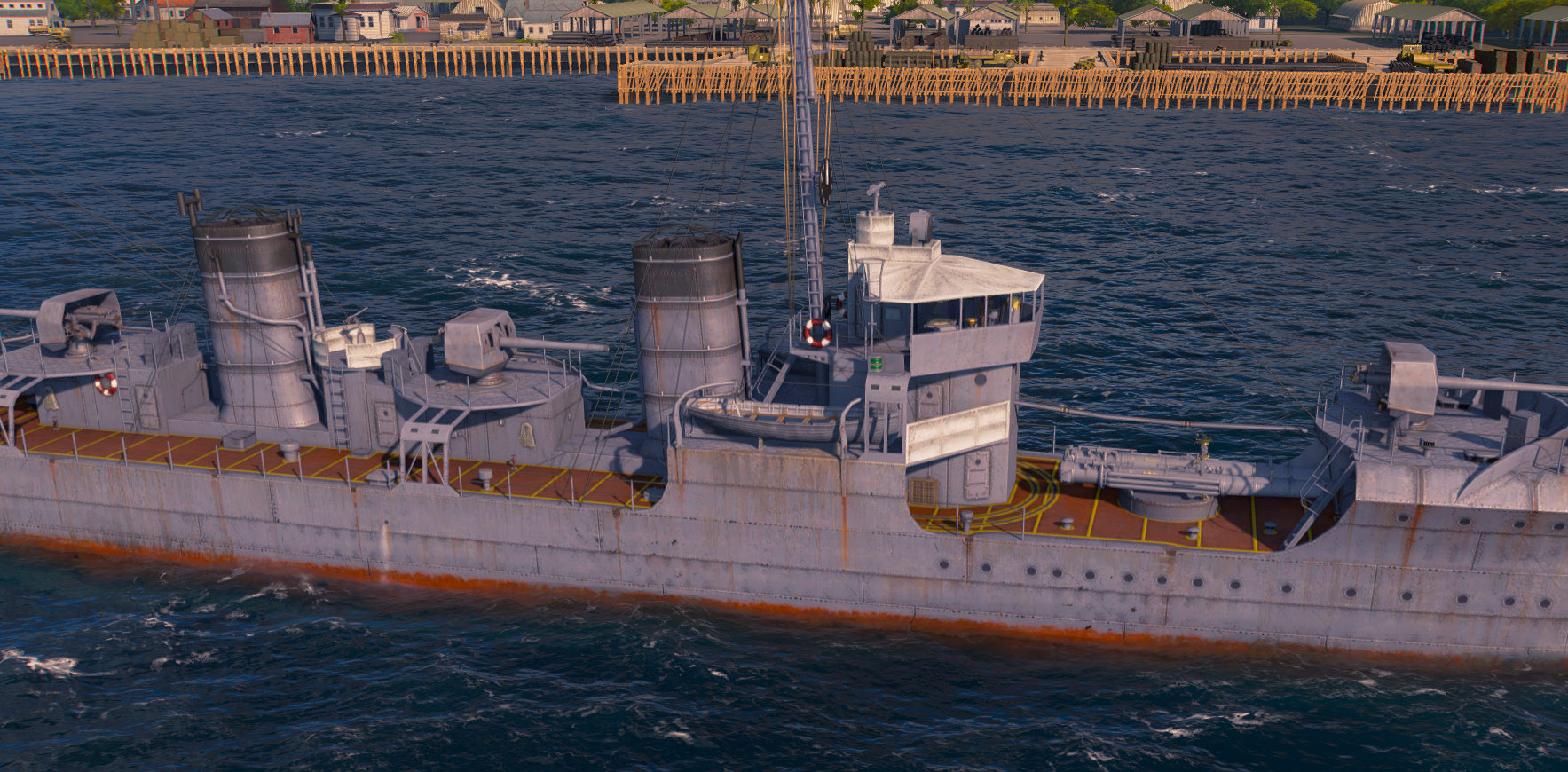
 Latest Facebook Entry -
Latest Facebook Entry -  X(Tweeter) Naval Encyclopedia's deck archive
X(Tweeter) Naval Encyclopedia's deck archive Instagram (@navalencyc)
Instagram (@navalencyc)





 French Navy
French Navy Royal Navy
Royal Navy Russian Navy
Russian Navy Armada Espanola
Armada Espanola Austrian Navy
Austrian Navy K.u.K. Kriegsmarine
K.u.K. Kriegsmarine Dansk Marine
Dansk Marine Nautiko Hellenon
Nautiko Hellenon Koninklije Marine 1870
Koninklije Marine 1870 Marinha do Brasil
Marinha do Brasil Osmanlı Donanması
Osmanlı Donanması Marina Do Peru
Marina Do Peru Marinha do Portugal
Marinha do Portugal Regia Marina 1870
Regia Marina 1870 Nihhon Kaigun 1870
Nihhon Kaigun 1870 Preußische Marine 1870
Preußische Marine 1870 Russkiy Flot 1870
Russkiy Flot 1870 Svenska marinen
Svenska marinen Søværnet
Søværnet Union Navy
Union Navy Confederate Navy
Confederate Navy Armada de Argentina
Armada de Argentina Imperial Chinese Navy
Imperial Chinese Navy Marinha do Portugal
Marinha do Portugal Mexico
Mexico Kaiserliche Marine
Kaiserliche Marine 1898 US Navy
1898 US Navy Sovietskiy Flot
Sovietskiy Flot Royal Canadian Navy
Royal Canadian Navy Royal Australian Navy
Royal Australian Navy RNZN Fleet
RNZN Fleet Chinese Navy 1937
Chinese Navy 1937 Kriegsmarine
Kriegsmarine Chilean Navy
Chilean Navy Danish Navy
Danish Navy Finnish Navy
Finnish Navy Hellenic Navy
Hellenic Navy Polish Navy
Polish Navy Romanian Navy
Romanian Navy Turkish Navy
Turkish Navy Royal Yugoslav Navy
Royal Yugoslav Navy Royal Thai Navy
Royal Thai Navy Minor Navies
Minor Navies Albania
Albania Austria
Austria Belgium
Belgium Columbia
Columbia Costa Rica
Costa Rica Cuba
Cuba Czechoslovakia
Czechoslovakia Dominican Republic
Dominican Republic Haiti
Haiti Hungary
Hungary Honduras
Honduras Estonia
Estonia Iceland
Iceland Eire
Eire Equador
Equador Iran
Iran Iraq
Iraq Latvia
Latvia Liberia
Liberia Lithuania
Lithuania Mandchukuo
Mandchukuo Morocco
Morocco Nicaragua
Nicaragua Persia
Persia San Salvador
San Salvador Sarawak
Sarawak Uruguay
Uruguay Venezuela
Venezuela Zanzibar
Zanzibar Warsaw Pact Navies
Warsaw Pact Navies Bulgaria
Bulgaria Hungary
Hungary

 Bundesmarine
Bundesmarine Dutch Navy
Dutch Navy Hellenic Navy
Hellenic Navy Marina Militare
Marina Militare Yugoslav Navy
Yugoslav Navy Chinese Navy
Chinese Navy Indian Navy
Indian Navy Indonesian Navy
Indonesian Navy JMSDF
JMSDF North Korean Navy
North Korean Navy Pakistani Navy
Pakistani Navy Philippines Navy
Philippines Navy ROKN
ROKN Rep. of Singapore Navy
Rep. of Singapore Navy Taiwanese Navy
Taiwanese Navy IDF Navy
IDF Navy Saudi Navy
Saudi Navy Royal New Zealand Navy
Royal New Zealand Navy Egyptian Navy
Egyptian Navy South African Navy
South African Navy






























 Ukrainian Navy
Ukrainian Navy dbodesign
dbodesign